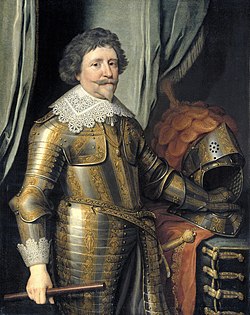Siege of Groenlo (1627)
Heavy taxes and import duties were collected here from the whole of the Achterhoek and Veluwe, which provided a steady source of income for the Spanish war treasury.
Together with the fortified towns of Oldenzaal, Bredevoort and Lingen, Grol could provide a base for attacking the republic from the east.
[3][4] The Dutch Army of Frederic-Henry, totaling over 15,000 footmen and 4,000 cavalry, traveled by foot and boat via the Rhine and unloaded behind Emmerich.
As was common practice in those days, the army consisted mainly of mercenaries from all over Europe, including Scottish, English, High-German, Frisian and French troops.
[6] The next day, thousands of soldiers and hired workers began to speedily build a continuous earthen wall around Grol, 10 feet high, 16 kilometers long.
Wooden and earthen ramparts, entrenchments and other fortifications were built along the line, including fortified defenses for the troops (Dutch: Schansen).
Frederic-Henry was aware that a large Spanish army was stationed in the south of the Netherlands, commanded by Hendrik van den Bergh.
Food and supplies aplenty, Dulken ordered his troops to reinforce the defenses of the already fortified city, and specifically: "...by musket or cannonball, to hurt or damage the enemy any which way".
Finally, with the support of two artillery pieces the attackers managed to build two dams, although casualties were great, including two English officers, Ram and Proud.
Having crossed the canal, they could now begin to undermine Grol's outer defensive walls, even though regular attacks were made from out of the city.
However, due to lack of funding they were short on supplies and had arrived too late for a head-to-head battle in the open field.
His attack on the Scottish rampart seemed to succeed at first, but a fierce counterattack by Officer Morre drove the Spaniards away, erasing all hope for a victory for Van den Bergh.
Dulken however, intelligent enough in knowing that soon his city would be attacked from three sides, and realizing that he was short on men and guns, called for an armistice and sent for negotiators.
Numerous paintings of the siege have been made famous by well known artists of the period In the town of Groenlo, old Grol, cannons and some parts of the old bulwarks have been restored for historic and tourism purposes.
Live reenactments of the events of 1627 take place on a regular basis, drawing sizable crowds - these are known as the 'Slag om Grolle'.
In the hot Dutch summer of 2003, an ultralight plane discovered mysteriously green plants in an otherwise barren corn field.
The event was held for the first time in 2005, and since then reenactors from France, Germany, United Kingdom, the Czech Republic as well as the Netherlands have taken part.






